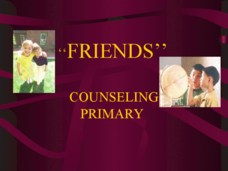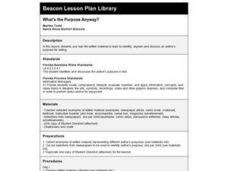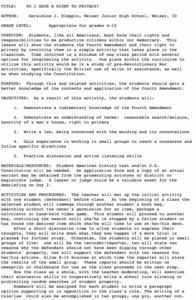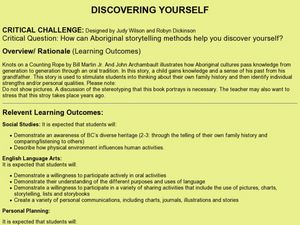Curated OER
Whale Is Stuck
Students engage in the process of problem solving with the help of children's literature story of how the whale was trapped and then freed. The story illustrates the power of teamwork and commitment. The students practice the skill of...
Curated OER
Johnny Appleseed
Students engage in a study of apples using children's literature. They conduct research using a variety of resources. Student list facts about apples and compare them while answering some guided questions. They plant some apple seeds and...
Curated OER
Immigration and Ellis Island
Fourth graders explore family histories. In this social studies lesson, 4th graders identify the countries from which their ancestors came and locate them on a map. Students discuss the role that Ellis Island played in immigration in the...
Curated OER
It's Raining Cats and Dogs! Literary Devices and Figurative Language
Third and fourth graders study literary devices and figurative language. They view a PowerPoint presentation (which you must create) to review hyperbole, idiom, simile, and metaphor. They read and discuss the book There's A Frog in...
Curated OER
Guided Reading Lesson Plan
The students will be invoived in a guided reading exercise. The lesson is performed in a small group setting. The monitoring of reading is done by the teacher and scaffolding can also be provided as necessary.
Curated OER
Lines Of Connection
We need the help of your history detectives! After giving them a set of questions to answer, reading groups must create their own timeline of the events. Then, as a class, have each group present their timelines. What is different? Why...
Curated OER
Necessity Is the Mother of Invention
Fifth graders explore the inventions of Thomas Edison. They, in groups, research inventions.
Curated OER
Friends
First graders use the software Inspiration to create a web describing characteristics of a good friend. With the use of a digital camera and PowerPoint, 1st graders create "Friends Found" posters after reading the book, "Don't Need...
Curated OER
Sectionalism in Early U.S.
Young scholars, divided into three groups, representing the Northeastern, Southern, Western United States. They research these areas in early American history and as a group prepare charts, graphs and reports. They explain their needs...
Curated OER
Comprehending Through Questioning
Elementary schoolers observe and apply a variety of reading comprehension strategies. They silently read a passage out of their science textbook, and discuss answering the who, what, where, when, and how of the text. In small groups they...
Curated OER
Joyful Noise: Poems for Two Voices by Paul Fleischman
Do your young readers know that poems can be performed as a team? They listen to a few examples from Paul Fleischman's book Joyful Noise: Poems for Two Voices, paying attention to how the how readers work together....
Curated OER
Story Map for Bud, Not Buddy
Why should your class complete a story map? After reading Bud, Not Buddy, divide your class into pairs or small groups to complete the included worksheet. They list the main characters, the conflict, main plot events, the resolution, and...
Curated OER
Whales
First graders investigate two different types of whales; toothed and baleen. They describe what the different types of whale eat. They listen to a cassette of Dyan Sheldon's, The Whale Song before making stick puppets to dramatize the...
Curated OER
General Music: Star Spangled Banner
"The Star Spangled Banner" became our country's national anthem, but why? Second and third grade musicians read about the song, analyze the lyrics, and discuss patriotism. They then complete a related word search.
Curated OER
The Pumpkin Patch - A Venture in Agritourism
After reading an article about how agritourism is helping boost the financial stability of local farms, middle schoolers answer comprehension questions. This is a case-study of Canadian pumpkin producers. It could be useful as a...
Curated OER
Lewis and Clark: Equipping the Expedition
Students examine the preparations made by Lewis and Clark before leaving on their expedition. They make predictions about what they believe the two explorers took and organize the list into a venn diagram. They compare their predictions...
Curated OER
Freak the Mighty: Chapter 18 Semantic Feature Analysis
Intelligent? Arrogant? Obnoxious? After completing Chapter 18 of Freak the Mighty, individuals fill out a semantic feature chart for characters in Rodman Philbrick's novel. Group members then use their charts to discuss relationships...
Curated OER
What's the Purpose Anyway?
Examine author's purpose in newspaper articles, comic books, cookbooks, encyclopedias and other forms of written materials. Working in groups, middle and high schoolers read teacher-selected articles and write an explanation of the...
Curated OER
Do I Have a Right To Privacy?
Students, in groups, explore the Fourth Amendment and their right to privacy. They explore reasonable search/seizure, sanctity of a man's house, right to privacy.
Curated OER
Cyber Memory--Let's Hope Not
Sixth graders continue to read excerpts from "The Last Book in the Universe". In groups, they discuss any questions they have about the material. They research an endangered threatened species and make a plea to the rest of the class...
BBC
Conflict
Middle schoolers take a close look at the different forms that bullying can take, and share their ideas of ways to stop bullying in schools. Learners get together in groups of three and come up with a scenario that depicts a...
Curated OER
Catcher in the Rye: Chapters 18-20 Venn Diagram
Well into Catcher in the Rye, when things are looking bleak and your readers may be needing some levity, read the picture book The Perfect Square by Michael Hall. Then use the Venn diagram included to compare how Holden Caulfield and the...
Curated OER
Discovering Yourself
Students explore Aboriginal storytelling. In this literature lesson, students read Knots on a Counting Rope and then create a story line as they discuss the attributes of Aboriginal culture. Students retell the story in their own words.
Curated OER
Help Me Learn About the Holocaust
Young readers select a book from a provided list to use as the basis for an intensive class study of Holocaust novels. After completing their novels, groups create a multimedia presentation highlighting the elements of literature...

























